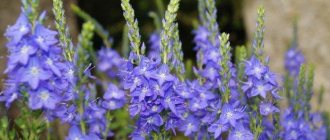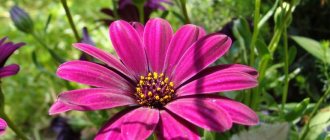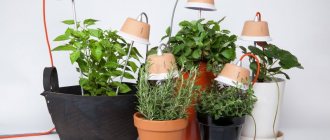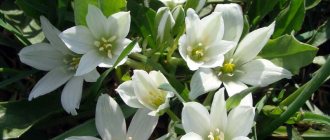Agapanthus is a perennial plant that is a very graceful blue flower with six petals. Also known as the "Lily of the Nile", because it originally grew in the south of the African continent, on mountain slopes and coasts.
Currently, due to its decorative value, it is grown both indoors and for landscaping garden plots, parks, and lawns.
The plant has characteristics of the onion, amaryllis, and lily families. The classification of the flower, being a subject of debate among scientists, led to its separation into an independent species - Agapantaceae. It is considered in many countries a symbol of success and prosperity. In Europe, the flower became popular in the 17th century.
Plant morphology
Agapanthus is a perennial herbaceous plant, up to 70 cm high. Even without flowers, agapanthus attracts attention with the decorative appearance of its dense rosette, which consists of belt-shaped, smooth, dark green leaves tapering towards the end. In mid-summer, slender, round, naked flower arrows appear from it, ending in large umbrella-shaped inflorescences. The inflorescence contains up to 150 bell-shaped flowers. The perianth consists of 6 petals fused at the base. The petals are blue, white and cream.
Agapanthus blooms from mid-summer to late autumn. After pollination of the flower, within one month, the seed box matures.
On a note!!!
Although agapanthus is a relative of the onion, it does not have a specific pungent odor, and its rhizome does not at all resemble an onion.
Agapanthus
In cultivation, the most common is A. umbellatus with ribbon-shaped grooved leaves and beautiful blue flowers located in an umbellate inflorescence at the top of a long peduncle.
The plant is most often grown in open ground, although there are growers who keep agapanthus at home.
Bloom
From July until the beginning of autumn, agapanthus produces smooth arrows with large fluffy umbrella-shaped inflorescences. Each inflorescence can contain up to hundreds of flowers. The colors of funnel-shaped agapanthus flowers are varied. The buds open in stages, which is why the plant enjoys its color for a long time. At the bottom of agapanthus flowers there are long thin spurs. At the end of flowering, fruit-pods with seeds are formed on the peduncles.
Agapanthus flowers
Agapanthus: lighting
Agapanthus loves well-lit places, reliably protected from the winds. Although the flower does not suffer much from drafts and usually tolerates them well. With a lack of light, the flower stalks begin to lengthen, which spoils the appearance of the plant and the flower may need supports.
The best options for agapanthus are windows located on the south, southeast and southwest sides.
On a note!!!
Lack of light negatively affects agapanthus. The flower stops blooming. Loses its beauty.
Requirements for soil and planting site
Agapanthus freezes in our climatic conditions and requires protected wintering, so it is usually grown in pots, which makes it easier to carry the flower indoors. The containers must be large enough, the plants hate being transplanted, they need to be filled with a layer of drainage (gravel, expanded clay) and then with standard soil. Pots should have holes in the bottom to allow water to drain freely.
Agapanthus prefer a substrate:
- well drained;
- moderately fertile;
- slightly damp;
- sandy-clayey;
- with a neutral reaction (only African Agapanthus requires an acidic substrate).
The pots are placed in places protected from strong winds and preferably strongly illuminated by the sun (at least 6-8 hours of sunlight per day). The best would be balconies and terraces with southern, southwestern or southeastern exposure.
Agapanthus also grows in partial shade, but the inflorescence will be less colored and the flowering will be less abundant.
During flowering, the plant should be protected from heavy rains due to the very fine structure of the flowers.
Planting an African lily
Agapanthus can be grown both at home and in open ground. The main thing is to provide the plant with favorable conditions. First of all, regular moderate watering, neutral or slightly acidic soil, warm air and good lighting.
Planting in the garden
Agapanthus, unlike many outdoor plants, does not tolerate wintering well in natural conditions. Sub-zero temperatures can destroy the plant.
Agapanthus in the garden
At temperatures below +10⁰С, the plant should be covered or dug up.
If agapanthus is grown in open ground, then its wintering must be approached thoroughly. In the southern regions of Russia, the plant is covered with a box, autumn leaves or sawdust. So agapanthus will overwinter without problems. In Siberia or in central Russia, a flower is dug up, placed in a box and put away in the basement until spring. You need to water the plant once, before storing it. Agapanthus should not be watered throughout the winter. In spring, the plant is planted again in the ground and watered abundantly.
Agapanthus loves light and should be given a sunny, open area in the garden. If there is not enough light, the peduncle will stretch out greatly and may break. To prevent this from happening, he will need to be tied.
When planting agapanthus in open ground, you need to remember that the plant needs:
- Nutritious soil. It should consist of humus - 2 parts, clay-turf soil - 2 parts, humus - 1 part, sand - 1 part.
- Light. It is advisable that the area with the flower be on the south, southeast and southwest sides.
- Temperature not lower than 10-12⁰С.
Abundant watering during the growing season. With the onset of cold weather, the frequency of watering needs to be reduced.
In dry air, the plant feels comfortable, so there is no need to additionally moisten the flower and spray it.
At home
Florists also grow agapanthus at home. To keep it you need to choose a pot. Which pot to choose for agapanthus? The flower container should be selected based on the size of the flower roots. The flowerpot should not be loose, but a little cramped, so the plant blooms better. At the same time, you should not plant a flower in a pot that is too small, as this will lead to inadequate development of the root system. In this case, small flowers are formed.
Agapanthus
Good drainage is also important for the plant. It can be crushed stone, pebbles or expanded clay.
Even at home, in winter, the plant needs rest. The temperature of its maintenance in winter should not exceed +15⁰С. During this period, you should water the flower rarely, just to moisten the roots and avoid them drying out.
With the onset of spring, the flower pot is moved to the south side and watered abundantly. So, you should take care of agapanthus until autumn. In summer, it is advisable to take the plant out into the fresh air.
How to properly plant an agapanthus bulb?
4 rules for planting agapanthus or African lily
- The agapanthus bulb is planted so that the roots are immersed to a depth of 8 cm
- You cannot plant more than one agapanthus in a pot with a diameter of 20 cm and no more than two in a pot with a diameter of 25 cm.
- Down the pot there is drainage, soil made of three equal parts: fertilized soil, one part soaked peat and one part sand.
- Before sprouting, the pot with the agapanthus bulb is watered moderately, and more often during the hot, dry period.
Agapanthus: propagation
Agapanthus has several methods of reproduction, these are:
- seeds;
- dividing the bush;
- shoots.
Each method is discussed below.
Agapanthus: propagation by shoots
Agapanthus are quite easy to propagate: baby plants are formed next to the mother plants, which can be planted in another container, where, with proper care, they will quickly grow. Seedlings must be separated carefully, trying not to damage the root system, otherwise the plant will not bloom.
Agapanthus
Agapanthus from seeds
Agapanthus is grown from seeds, like any other plant. Two hours before planting, the seeds are soaked in water for 2 hours. Sow the seeds in March, in a mixture of leaf soil and sand, sprinkle soil on top and create a wig effect (cover with glass). Keeping the ground moist all the time. Ventilate 1-2 times a day, removing the glass from the pot for 30-40 minutes.
Agapanthus seeds
On a note!!!
The effect will be better if the seeds are planted in a peat tablet.
As soon as the first leaves appear, the plant needs to be transplanted into another pot with more fertile soil.
Agapanthus shoots from seeds
Agapanthus: propagation by dividing the bush
In the spring, when transplanting, the plant can be divided. The root system is carefully cut, and the sections are processed and dried. To dry, the cut is left open, and the remaining roots are wrapped in a damp cloth and left for a couple of days. After this treatment, the flower can be planted in the soil. When the agapanthus begins to grow, begin full, abundant watering.
Agapanthus propagation by dividing the bush
If agapanthus is planted in open ground, then by autumn its root system will spread very far in different directions. And here, when digging, you can damage the roots so that the plant will not bloom next year. Therefore, it is better to plant it in the garden, digging it directly into containers.
Pest and disease control
For all its demands on space, light and humidity, agapanthus does not cause any trouble at all when it comes to immunity. He almost never gets sick. Even for fungus to appear, you need to flood the root system for a very long time and systematically. And all because the plant contains its own antiseptic and fungicidal substances.
Sometimes scale insects and spider mites hide in the depths of the outlet. But their occurrence can be easily prevented if you maintain optimal air humidity and do not forget about scheduled spraying. And the simplest complex insecticides help fight insects well.
Photo: floraplanet.com
Pushkinia (60 photos): types, planting and care in open ground
Agapanthus: diseases
Agapanthus is susceptible to disease. Most often he has:
- The leaves are turning yellow. The reason is waterlogging of the soil. Watering should be adjusted.
- Peduncles are strongly elongated. Insufficient lighting, agapanthus loves light.
- The leaves dry out and fall off. The plant is damaged by spider mites or scale insects. Treat the plant with soap foam several times or use Actellik.
Proper care makes the plant stronger and helps it fight diseases and pests.
Flower from legend
Umbrella agapanthus is also called African or Nile lily and other names, for example, Abyssinian beauty. From ancient legends it is clear that in Ethiopia (then Abyssinia) there lived a girl of indescribable charm. Everything was orderly and fine in this tribe until the young maiden decided to become a Christian.
This contradicted the pagan views of his fellow tribesmen. The brutal Abyssinians killed the maiden. Soon, at the place of death, they saw a graceful flower, reminding the barbarians of the destroyed beauty. For thousands of years in eastern Africa, the Agapanthus umbellata plant has been a symbol of good luck in everything and abundance. When Abyssinia was part of Ancient Egypt, it was called the Nile lily.
The ancient Greeks, masters of multiple legends, gave it its current name - “flower of love” (“agape” - love and “anthos” - flower). What do the Greeks have to do with this, you ask? Moreover, Ancient Egypt was conquered by A. Macedonian and Greek pharaohs ruled there. And the Nile is the main river of Egypt, where gorgeous lilies grew.
For a long time, botanists did not know which family to include agapanthus - onion, lily or amaryllis. They agreed on a separate species – agapanthaceae.
Important care points
In order for the flower to grow beautifully and please the eye, the following care points should be taken into account:
- provide good watering at the time of flowering;
- the plant is planted in large containers and tubs.
Agapanthus will be a wonderful addition to any outdoor flower arrangement and will decorate any alley, park, square, or garden. Frost-resistant and not afraid of drafts. When growing agapanthus at home, it should be taken out into the garden or onto an open balcony in the summer.
In outdoor conditions, the plant looks more powerful than in indoor conditions. Develops faster. It blooms better and more luxuriantly.
Description
Looking at a photo of agapanthus, an inexperienced inhabitant may think that he could have seen it in the fields of his grandmother’s village or in the forest. However, it is not. The natural habitat of agapanthus is South and Central Africa. For the most part it grows on dry slopes along the sea or ocean.
Agapanthus has small, curly and strong rhizomes. The leaves are long, linear in shape, and have a basal structure. During the flowering period, it begins to throw out a large peduncle, which reaches a length of up to one meter. The flower blooms predominantly blue. However, depending on the climate and environment, the color may be white or purple.
The plant blooms in large inflorescences; the number of flowers in one such bud can reach 150 flowers, having a long funnel shape. Probably, it is precisely due to the shape of the flowers that many attribute them to the lily family.
The plant blooms gradually over several months.
Agapanthus: types
There are several types of this plant. Each of them is unique and interesting in its own way. The most popular varieties of agapanthus are presented below.
Umbrella Agapanthus (Agapanthus umbellatus)
It is also called African lily or Abyssinian beauty. Originally from South Africa (Cape Province). This is a herbaceous rhizomatous plant up to 70 cm high. It is distinguished by the decorative appearance of a dense rosette of strap-shaped, smooth, dark green, grooved leaves tapering at the ends. Many blue or funnel-shaped flowers are collected in umbellate inflorescences on a long peduncle. The perianth consists of 6 petals fused at the base. Blooms in June-July. The seeds ripen in 35-40 days.
Umbrella Agapanthus (Agapanthus umbellatus L'Her)
Agapanthus orientalis
Originally from South Africa. Perennial herbaceous evergreen plant. The leaves are broad-linear, thick, curved. Peduncle 60 cm tall. The umbrella-shaped inflorescence consists of a large number of flowers (about 100). The flowers are blue and open in July–August.
Agapanthus orientalis
Agapanthus campanulatus
Grows on damp mountain slopes in South Africa. Perennial herbaceous deciduous plant. The leaves are linear, up to 15 cm long, erect. The flowers are bell-shaped, blue. Flowering occurs in July–August.
Agapanthus campanulatus
Agapanthus closed (Agapanthus inapertus Beauverd)
Grows in eastern southern Africa. It has drooping, unopening dark blue or purple flowers. The leaves are green with a bluish tint. Reaches 1.5 meters in height. Some specimens may be deciduous. Blooms from late summer to mid-autumn.
Agapanthus closed (Agapanthus inapertus Beauverd)
Agapanthus blue baby
The bush is low, 15-18 cm tall, compact, almost spherical. The shoots are strong, thick, densely pubescent. The leaves are large, pubescent on the underside. The inflorescences are baskets, dense, large, 1.5-1.7 cm in diameter, the stigmas of the styles are long, dark lilac-blue. Late variety. Blooms from mid-June to October. Drought resistant. Used in flower beds, ridges, and potted plants.
Agapanthus blue baby
Agapanthus Peter pan
A dwarf specimen with blue flowers at the age of three, it is a graceful plant about 45 cm high. The plant is suitable for cutting and arranging bouquets. Flowering: from May to October in open ground, can also bloom in winter if placed near a heat source.
Agapanthus Peter pan
Аgapanthus Mood Indigo
Agapanthus grows quickly, but does not like to be transplanted, so it is recommended to immediately plant it in large pots. It can be grown as a tub crop. But it should be understood that agapanthus blooms better in a cramped pot, and the “divisions” should be well-grown.
Аgapanthus Mood Indigo
Agapanthus Blue Perfection
The bush is compact, highly branched, almost spherical, 25-30 cm tall, with strong, highly pubescent shoots with a purple tint on the sunny side. The leaves are large, on long petioles. Baskets are 1.5-1.7 cm in diameter, lilac-blue. The inflorescences are medium dense, multi-flowered. The variety is early, blooms from the beginning of June.
Agapanthus Blue Perfection
Agapanthus Tinkerbell
Agapanthus is compact in size. The leaves are elongated, longitudinal, and have a white edging along the edges. Even without flowers the plant looks gorgeous. Peduncle in the shape of a ball. The flowers are light blue and light purple, bell-shaped.
Agapanthus Tinkerbell
Agapanthus Alba (Alba)
Alba is a compact, spherical bush, up to 20 cm tall. The inflorescences are white, dense, reminiscent of balls
Agapanthus alba
Agapanthus are easily crossed and provide rich material for selection. They can be used in various flower arrangements. They are so beautiful that they will decorate any home and garden without any problems.
Application in the garden
Agapanthus planted in pots are a very elegant and versatile decoration for terraces, balconies, gazebos, garden paths, and lawns. As a rhizomatous plant, thanks to careful care, they will delight you with long, abundant and truly fabulous flowering. And located near the ground, long dark green leaves grow in the shape of a fountain, decorating the landscape.
They look great individually or in groups – plain or colored. They make beautiful borders to separate a garden dining room or swimming pool, and they also make a great front door decoration if the lighting conditions are right.
The agapanthus flower can be planted directly in flower beds, in fairly fertile, well-drained soil, and dug up and transferred to a cool room for the winter. In flower beds it should be combined with garden plants:
- lavender,
- lily,
- decorative sage,
- common yarrow,
- echinacea purpurea,
- decorative garlic,
- crocosmia,
- alyssum,
- low varieties of hydrangeas.
Photo. Agapanthus in the garden
Charming inflorescences can be used to decorate your home in the form of bouquets. To do this, cut the stems at an angle of 45 degrees in the phase when 1/4 of the flowers are developed. Place flowers in vases with warm water; it is optimal to use special fertilizers - products for extending the life of cut flowers. Vases should be placed away from heat sources and direct sunlight.
Agapanthus is a very hardy plant that is easy to grow and care for. With just a little basic knowledge, you can enjoy the beautiful flowers of the African lily every year.











